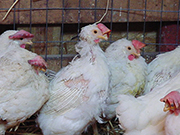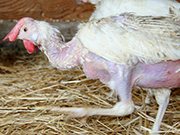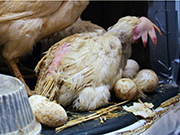
| Home | About | FAQs | Feedback | Take Action | Downloads | MythWatch | Advanced Advocacy | Store |
|
'Cage-free' Test
|
Truthiness: something that is spoken as if true, that one wants others to believe is true, that said often enough with enough voices orchestrated in behind it, might even sound true, but is not true. Many leaders in today's animal movement are supporting and even helping develop animal product labeling schemes and "animal compassionate" husbandry standards. Some are even promoting animal products such as eggs bearing a "cage-free" label. This rapidly accelerating trend is being celebrated by some as a "new level of engagement" with industry, and criticized by others as nothing less than the industry's wholesale co-option of the animals' cause. Participating advocates have brushed off suggestions that they have a conflict of interest. "The claim that we are in bed with the industry," said one senior staffer at a large animal welfare organization, "ignores the fact that every major industry group identifies us as a huge threat." But is there more to the story? This same staffer was reported to be a participant in an April 28, 2005 meeting between his advocacy organization and producers of industrialized "cage-free" eggs. As noted on the blog of industry attendee Joel Salatin, this "inaugural and historic" meeting focused on "brainstorming" the launch of a national anti-battery cage campaign that would promote "cage-free" eggs as the alternative. Salatin observed how "breaking in to the Wal-Marts of the world consumed the discussion time," and how "all the other producers were salivating over more market—one admitted he was sitting on 700 cases (that's 21,000 dozen) per week right now that he doesn't have a market for." Salatin added that the largest producer at the meeting, whom he referred to as "the kingpin," assured animal advocates that all the right industry "players" were there. The kingpin's point, according to Salatin, was that "the campaign would promote only those of us at the table. She expected a business bonanza." So whether they are "in bed" or not, at least one major animal organization and several large-scale animal exploiters appear to be engaged in a significant collaborative relationship, to such a degree that egg producers were said to be "salivating" and "expecting a business bonanza." Reform, or Reinforcement? In 2001, Bill Moyer, an activist with 40 years experience in the civil rights, anti-war and anti-nuclear movements, published Doing Democracy. This landmark book, which shows how the ups and downs of social movements generally follow a predictable pattern, gives activists a model for dramatically increasing their effectiveness. Moyer points out that successful movements require activists to fulfill four distinct roles. One of these is the role of "reformers," individuals and large organizations focused on getting the movement's goals, values and alternatives adopted into laws, institutional policies and industry practice. Reformers are said to be especially instrumental in the later stages of the process of social change. But Moyer points out there can be a dark side to reform-focused organizations that shows up, tragically, just when a movement is hitting its stride. The movement's opposition—in this case, the animal exploiting industries—sensing increased public sympathy for the cause, tries "to split or undercut the movement by offering minor reforms," and "the ineffective reformers start making agreements in the name of 'realistic politics,' usually over the objections of grassroots groups." Why? Moyer suggests that collaborating with the opposition can offer substantial financial and public relations benefits to individual organizations, even while the movement as a whole may suffer grievous harm. The staff of large organizations can sometimes forget their role as stewards of a movement's grassroots power, notes Moyer, and instead of fostering democracy in their organizations and in the movement as a whole, start acting as self-appointed leaders. They "behave as if they represent the movement, deciding on strategies and programs for the entire movement and then sending directives down to the local levels." Moyer makes clear how this "oppressive, hierarchical behavior, combined with conservative politics," divides the movement, splitting large organizations off from grassroots activists. This is a serious problem, he emphasizes, because "the power of social movements is based in the grassroots." In Moyer's reformers-gone-wrong scenario, the professionals running large organizations may even come to identify more with their counterparts in the opposition than with the grassroots folk whose donations pay their salaries, and whose hard work makes their programs come alive. As a result, a movement can lose its way, "either through collusion or compromises by reformer activists that undercut the achievement of critical movement goals." Which returns us to the proliferation of advocacy-approved animal product labeling schemes, and the ensuing identity theft now plaguing the vegan and animal rights movements. In a recent New York Times article titled Meat Labels Hope to Lure the Sensitive Carnivore, John Mackey, founder and CEO of Whole Foods, one of the largest meat retailers in America, is described as "a vegan who is increasingly outspoken on animal rights issues." In the same article, the American Humane Association and Humane Farm Animal Care, both with a clear focus on animal husbandry reforms and not on the boycott of animal products or the abolition of animal exploitation, are referred to as "animal rights organizations." But what's the harm, proponents say, they're only words, aren't they? In the same New York Times article, one grocery chain boasted a 25 percent jump in meat sales since it added the "certified humane" logo, even though these products cost, on average, 30 to 40 percent more. It seems the industry has more than a few reasons to be salivating over its new collaboration with the animal advocacy movement. A Moment of Truthiness But how could intelligent and experienced activist leaders get drawn into a rather predictable industry trap? Perhaps they have failed to grasp that the values that drive a social justice movement are inherently incompatible with those of a business based on exploiting the very beings the movement has pledged to protect. When the moral framework of a social justice cause is deliberately co-mingled with the utilitarian, profit-maximizing logic of an exploitative industry, what was once a natural adversarial relationship gets twisted into a dysfunctional marriage of convenience. To make such an unnatural alliance work, critical thinking, the very catalyst of conscience, must be neutralized through the manipulations of public relations.
As a strategy to end the use of battery cages, for example, several animal organizations are encouraging members and supporters to persuade individuals and institutions to switch to eggs labeled "cage-free." One of the architects of this campaign has stated that the term "cage-free" is not misleading at all, "for even though the hens are confined in artificial indoor environments, technically speaking, they are not in actual cages." But being technically factual and telling the truth are not necessarily the same. Just ask members of the general public to imagine the lives of chickens who produce "cage-free" eggs. Most will likely envision something akin to the mythical "Old MacDonald's Farm," contented animals freely wandering about a bucolic barnyard. The reality? Millions of young hens standing shoulder to shoulder in huge enclosed warehouses, forced to dwell day and night in their own waste, enduring air so foul that workers sometimes wear gas masks to prevent permanent damage to their lungs. Just like their battery-caged sisters, "cage-free" hens are brutally debeaked, force molted (starved for days to restart an egg laying cycle), and, of course, slaughtered when they are no longer of use. Or, as one investigator discovered, if no buyer can be found for their ravaged bodies, they might just be packed into steel drums and gassed, the piles of their lifeless remains sent to a landfill or used as compost. Not to mention the millions of male chicks who, incapable of laying eggs, are unceremoniously suffocated in plastic bags or ground alive into fertilizer or feed, their lives snuffed out before they even begin. "New and Improved" Abuse? If we pursue justice by collaborating with industry, by helping develop and promote what we tell ourselves are slightly less hideous forms of exploitation, are we not attempting to displace one form of abuse with another?
Even more troubling, we animal advocates cannot successfully carry out such a strategy without ourselves directly taking part in misleading the general public. Consider, for example, what it takes to successfully "sell" the idea that buying and consuming eggs labeled "cage-free" is socially responsible, and even compassionate. If the full reality of "cage-free" egg production, or any other systematized exploitation of animals were to be revealed, wouldn't it be impossible to convince large numbers of people to support it? Hence, to promote "cage-free" eggs, we must step across the invisible but critical line that separates an advocate from an apologist. From Cage-free to Cruelty-free: How Truthiness Becomes Fiction Let's examine some of the statements that have appeared in local media where "cage-free" egg campaigns have run. Watch as the pressure to close the sale leads to the inevitable blurring of fact and fiction: One student animal rights group characterizes their "cage-free" campaign as trying to get their college's food service to no longer purchase its eggs from "large factory farms with cruel conditions." The group's leader states that "factory farms and caged hens are harmful to the environment," and that "cage-free eggs are good for the animals and local farmers." At another college, animal The truth is, most "cage-free" eggs are produced on industrialized farms, and there is little evidence to suggest "cage-free" production techniques are less harmful to the environment. They are certainly not "good for" animals. Said one doctoral candidate, "If entire nations across Europe can ban battery cages and go cruelty-free, then I'm optimistic that [our university] certainly can as well!" But can an industry that mutilates and kills the young animals it exploits truthfully be called "cruelty-free"? At another college, a student sponsor of a successful "cage-free" campaign says, "It's good that this university can show that we're compassionate toward animal rights." So switching to eggs labeled "cage-free" is now an expression of animal rights, a philosophy that rejects all exploitation and boycotts the consumption of animal products? "We're happy to do it,'' said the food manager for a Fortune 500 company. "There's a ripple effect that I think will happen. Other companies also will want to ensure humane treatment of animals.'' As one astute activist pointed out, terms that can be used in a relative sense when communicating with animal activists, are now being applied in an absolute sense when selling consumers on these "new and improved" animal products. So while one might choose to argue that some forms of exploitation and killing are less inhumane or less cruel than others, an informed advocate cannot honestly characterize any form of exploitation and killing as humane or free of cruelty. Yet this is exactly what the public is being led to believe. Imagine what it means to do all the work needed to pull down the veil covering over the horrific injustice of battery egg production, and then, to turn around and methodically cover it up again with a new and improved facade: "Cage-free" eggs—the cruelty-free, socially responsible, environmentally sustainable alternative. Good for the animals, good for farmers, good for workers, good for you. This, at a time when more and more people around the world are being addicted to an animal protein-centered diet, the proven cause of most chronic illness. This, at a time when we face record obesity, and avian influenza looms as the next pandemic. This, at a time when UN researchers have determined that animal agriculture produces more global warming impact than all the world's cars, trucks, buses, planes, trains and ships combined. And Let's Not Forget, They're Tastier Too A repeating theme of news stories around the "cage-free" egg campaign, actually common to much of the coverage of advocate-approved labeling schemes, is how delicious these "new and improved" animal products are. One campus dining service conducted a taste test, failing to find even one student who didn't think "cage-free" eggs tasted better. Another dining manager was quoted complimenting their freshness. She spoke of how one of their chefs "made banana bread with the eggs and said the bread rose to be lighter and fluffier," and how "students seem interested in tasting the eggs," concluding that "people seem to be eating more eggs just to try them out." Is there any doubt our cause is being co-opted? But how can anyone blame well-meaning activists for contributing to the growing smorgasbord of mis- and dis-information? After all, they've been convinced by people they admire that if they tell the truth, they will not reduce suffering as much as by offering up the false reassurances of truthiness. They've been convinced that replacing one form of abuse with another is a viable path to ending exploitation. As the core values and principles of the movement are perversely put in service of selling the very products of suffering and exploitation they were intended to abolish, people of integrity and goodwill become increasingly disoriented. They lose their ability to recognize they've been drawn into a destructive conflict of interest, mistaking it for "pragmatism" and "common sense." A Half Truth is a Whole Lie Is it time to take a look in the mirror? Do we really want to convince our most idealistic young people that skillful manipulation is a surefire path to a better world? That PR spin, and not teaching, is the answer? Do we want to perpetuate the destructive fantasy that a social justice movement can be run like a multi-national corporation? Ignorance, denial and dishonesty are at the very root, not just of exploitation itself, but of the social and psychological forces that allow its toleration. When we are willing to sacrifice the truth, to dilute its power in order to accrue short-term gains, however noble they may seem to be, we break free of our ethical moorings and begin to drift off course, inevitably carried away by the same currents that drive those caught up in exploitation. In our heart of hearts, we know there is a better path. If we take the time to listen, our conscience will show us the way.
Below are two short videos that offer contrasting messages to the public about what is being supported when consumers buy "cage free" eggs. One was produced by a multi-million dollar organization, the other by a grassroots animal sanctuary with a small budget. As you watch, ask yourself how well each of them does at teaching the public about the reality of "cage free" egg production. Consider how successfully each of them meets the challenge of encouraging critical thinking about the ethics of using and killing animals. James Laveck is a social justice filmmaker, along with partner Jenny Stein. Together they founded Tribe of Heart, and along with Eric Huang, co-founded HumaneMyth.org. Their award-winning documentaries, The Witness and Peaceable Kingdom: The Journey Home may be watched for free in English, French, German, Portuguese and Spanish at Tribe of Heart’s Global Tribal Cinema. They are currently working on their newest documentary, LEGACY, along with developing Holistic Nonviolence, a new path for personal transformation and social evolution. |







 While it is questionable whether such a strategy could eventually lead to the end of exploitation, one thing is certain: when animal advocates encourage the public to accept "new and improved" forms of abuse, we are powerfully reinforcing the status of nonhuman animals as property, to be acquired, used and disposed of at will. We are also significantly bolstering the credibility and positive public image of an industry with a long history of betraying public trust.
While it is questionable whether such a strategy could eventually lead to the end of exploitation, one thing is certain: when animal advocates encourage the public to accept "new and improved" forms of abuse, we are powerfully reinforcing the status of nonhuman animals as property, to be acquired, used and disposed of at will. We are also significantly bolstering the credibility and positive public image of an industry with a long history of betraying public trust. advocates state that if the university would switch to eggs labeled "cage-free," "we could pride ourselves on knowing that these birds were living a decent life," and that they'd no longer be supporting "environmentally unsustainable practices that exploit the land, the workers, the animals."
advocates state that if the university would switch to eggs labeled "cage-free," "we could pride ourselves on knowing that these birds were living a decent life," and that they'd no longer be supporting "environmentally unsustainable practices that exploit the land, the workers, the animals."